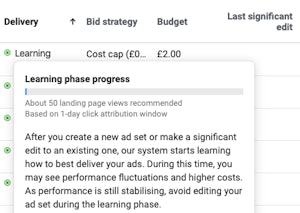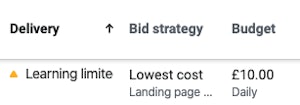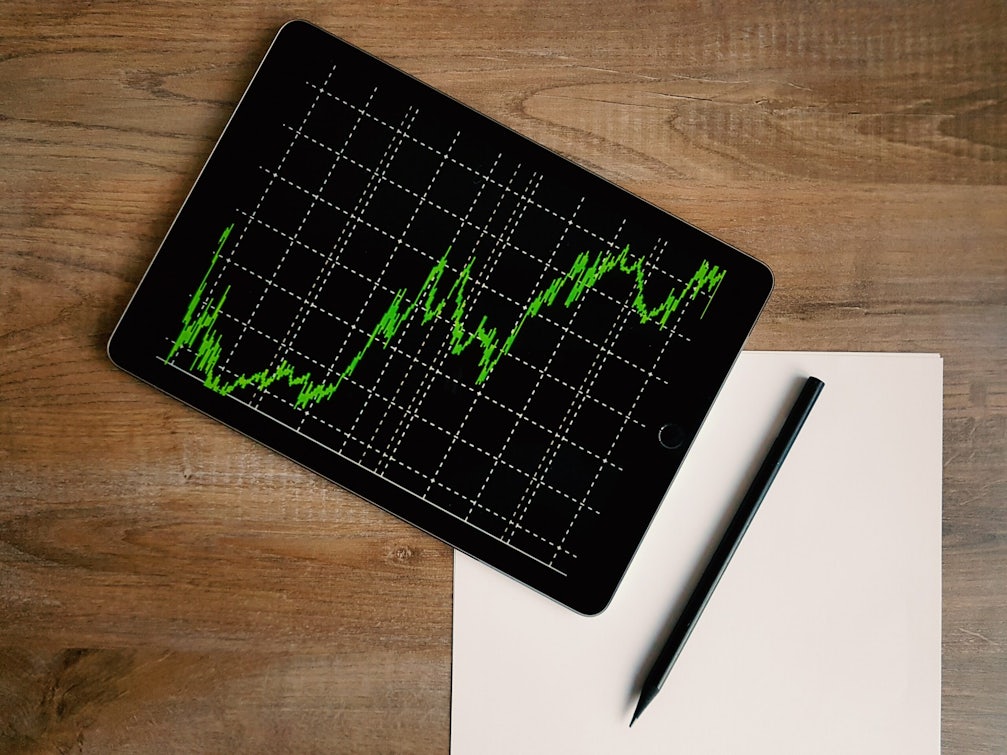Thanks to machine learning, Facebook’s Ads Manager is an increasingly intelligent system. The Facebook learning phase is one way in which its algorithm tests and improves your ad performance.
In this blog, we’ll demystify the learning phase, and help you work with Facebook’s algorithm to get brilliant results.
What is the Facebook ads learning phase?
Facebook’s learning phase is the delivery system’s way of optimising the ad’s performance.
Each time an ad is shown, it learns more about the best people and places to show the ad. The more data it gathers, the quicker it is to learn what’s working.
During the learning phase, Facebook is still exploring the best way to deliver your ad set – so performance is less stable and cost per action (CPA) is usually worse. The learning phase occurs when you create a new ad or ad set or make a significant edit to an existing one.
How long does it last?
Technically, forever – as Facebook’s continually learning about the best way to deliver an ad set. But when referring to the initial ‘Learning Phase’ – ad sets exit the learning phase as soon as performance stabilises – around 50 conversions.
How can I tell if my ad’s still in the learning phase?
Easy – if the Delivery column reads “Learning”, your ad or ad set is in the learning phase.
Hover over the delivery column and you’ll see a progress bar with more detail.

Why does the learning phase matter?
Understanding how Facebook’s algorithm works is key to getting consistently great results from your Facebook Ads campaigns.
Working with the algorithm, not against it, will help you lower cost per action (CPA) over time. Accidentally triggering the learning phase will hinder campaigns as you’re not providing Facebook with enough data to get your ads working.
Aside from CPA, avoiding changes in the learning phase will help your learning. It’s easier to decode results if you can apply changes to a stable campaign, and pinpoint before/after.
Following Facebook’s mysterious rulebook can be difficult, but read on for our tips to master the learning phase and avoid common mistakes.
Why has the learning phase started again?
Facebook Ad’s learning phase is sensitive – resetting the learning phase is all too easy to do.
What causes re-entering the learning phase?
-
-
- Any change to:
- Targeting
- Ad creative
- Optimisation events
- Adding a new ad to your ad set
- Pausing your ad set for seven days or longer (the ad set re-enters the learning phase once you unpause the ad set)
- Changing the bid strategy
- Any change to:
-
What might cause re-entering the learning phase?
- Adding a Bid control, cost control or ROAS control
- Changing budget – as a rule of thumb – 20% or more is significant
What changes can I safely make?
Most changes risk resetting learning, but smaller changes should be OK:
- Renaming campaigns
- Adding cost caps
- Small changes to budget
- Adding a new ad set or making changes to one ad set within a wider campaign. It will cause the edited/new ad to reset, but not the campaign as a whole
Make sure you check all your variables when launching a campaign, get sign-off from your client on the creative, and try to avoid making silly mistakes that you’ll need to fix later.
When your ads have launched – resist the urge to leap into action. Costs may be high at first, but avoid making too many kneejerk changes while Facebook’s still figuring it out.
How can I speed up the learning phase?
First, avoid making early changes and putting your learning phase back to square one.
Next, work with Facebook Ads to give it as much data as possible so that you can hit those magic 50 conversion events ASAP.
Here’s how to speed things along:
- Don’t spread your budget too thin
- Consolidate similar ad sets and campaigns – this makes sure each ad gets a chance to collect data
- Don’t create a huge volume of ads – testing is great, but make sure to get the balance right by layering in tests alongside more stable learning
- What’s your expected CPA? If you expect to pay £2 per conversion, ensure you have allocated enough budget upfront to cover at least 50 conversions
- Choose the right optimisation event
- If your event isn’t being triggered often enough to finish the learning phase, try optimising for a more common event. For example, if aiming for sales, try optimising for Add to Cart.
- Don’t forget to factor in your conversion window! If your product or service requires longer consideration times, ensure window is set for 7 days after clicks for delayed conversions to be counted
- If your event isn’t being triggered often enough to finish the learning phase, try optimising for a more common event. For example, if aiming for sales, try optimising for Add to Cart.
- Pay attention to Learning Limited

-
- You’ll see this amber warning if your ads have finished the initial learning phase – but your ad set isn’t generating enough results to exit the learning phase
-
- Consider making changes to your ad set to improve performance. Learning Limited usually occurs when the ads are constrained by audience size, cost control, budget or other settings.
- For example, if you’re trying to retarget a narrow custom audience of website traffic, and have a frequency of 2 or more, Facebook’s already done all the learning it can.
- Try to expand the number of people your campaign can reach by relaxing your rules (date ranges, exclusions) or layering in an upper-funnel campaign driving more overall traffic to your website
- Note – Learning limited feature is not available for all accounts – find out more here.
What to do when the learning phase is complete?
If your ads now show as Active – Facebook’s initial learning is done!
Next steps:
If you’re happy with the results – leave it running. You can create new campaigns alongside the stable campaign to conduct tests and hopefully drive CPA down even further. May the algorithm be ever in your favour.
If you’re not happy with performance, analyse your results and make optimisations within the original campaign. This will reset the learning phase, but it’s likely to take less time than the first learning phase.
Key takeaways
- The learning phase is a vital part of Facebook’s ad set optimization process.
- It usually takes 50 optimization events for initial learning to finish – and learning is reset when significant edits are made to an ad set or the ads within it.
- You shouldn’t make significant changes to your Facebook ad sets during the learning phase if you can avoid it.
- During a Facebook ad’s learning phase you are likely to see inconsistent and fluctuating results – but you should not judge performance until after the learning phase has been completed.
Hopefully, this article gave you more insight into Facebook’s learning phase.
If you’re interested in finding out how Impression can help your business get great results through paid social, you can get in touch here.



